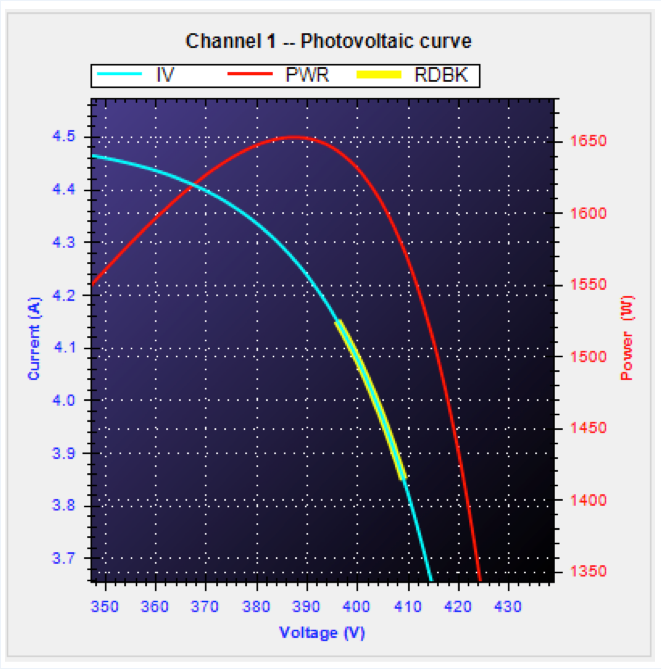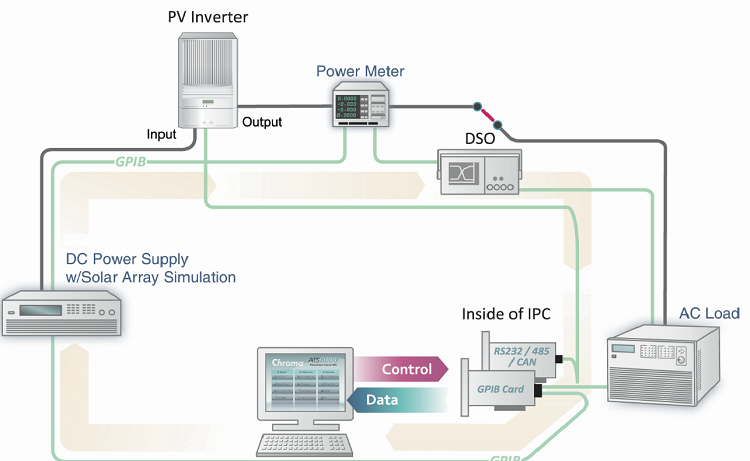BY DAN ROMANCHIK, contributing writer
By almost any measure, solar power is hot. According to the Solar Energy Industries Association (SEIA), more than 15 GW of capacity was installed in 2016, and while installations are expected to slow in 2017, it’s clear that the trend is increased solar capacity over the next five years. SEIA predicts that by 2022, more than 17 GW of solar power will be installed annually.
One of the factors driving solar system sales is reduced prices for photovoltaic (PV) arrays. In 2016, prices for PV arrays dropped below $1/W for the first time. Another factor is improved inverter design, and a significant contributor to better design is better test equipment with which to test them. Several companies, including AMETEK Programmable Power, Chroma Systems Solutions, and Keysight Technologies, make solar array simulators.
Testing at MPP
To deliver the maximum amount of power from solar panels or arrays, standalone inverters and grid-tie inverters find the maximum power point (MPP) for given conditions. They vary the load on the solar panel or array until it finds the point on the panel’s or array’s I-V curve that will deliver the most power. The inverter then converts this DC power to AC power, which is then used locally or fed into the power grid. Fig. 1 shows an I-V curve for a typical solar array and the power that is available at points along the curve.
Fig. 1: The blue line on this graph shows the I-V curve of a typical solar cell. The red line shows the power available at points along the curve. Image source: AMETEK Programmable Power.
To effectively test the efficiency of photovoltaic inverters, you need a solar array simulator that accurately simulates the output of a solar panel or array. Using actual solar panels or arrays is just not practical because you can’t control their output to the degree required to simulate all conditions.
To simulate a solar panel or array, inverter designers and manufacturers use modern, digitally controlled power supplies. When coupled with control software, these systems can simulate solar panel arrays up to 1 MW.
Accurately simulating a solar array to test inverters can be quite a challenge. As noted earlier, inverters continually change their input impedance, searching for the MPP. The simulator must respond to those load changes as a solar array would. Not only must the simulator maintain its power output, it must track the I-V curve of the solar panel or array that it’s simulating.
To complicate matters, many solar inverters generate AC ripple on their DC input, which is connected to the PV array. For single-phase inverters, the ripple frequency is twice the line frequency (120 Hz for U.S. models). Normally, you want a power supply to suppress this ripple, but a solar array simulator’s power supply must not suppress it. That’s because an increasing number of inverters (and virtually all micro-inverters) accurately measure the amplitude and phase of the ripple voltage and current to quickly determine the array’s MPP. This approach lets inverters find the MPP faster than converters that use conventional dithering techniques (sometimes called “perturbate-and-observe”). Faster MPP tracking results in higher efficiency in cloudy conditions, where the irradiance constantly changes.
Another requirement for modern solar array simulators is flexibility. Each solar array has its own characteristics. Solar array simulators must be programmable, letting them determine how inverter designs will work with all of these different types of solar arrays.
Finally, solar array simulators need to measure and log the inverter’s AC output and correlate that data with the DC power input. This closes the test loop and lets you see your inverter design’s efficiency. A block diagram of a complete system is shown in Fig. 2 . Fig. 2: A system capable of testing a PV inverter in off-grid mode consists of a DC power supply to simulate a PV array, a power meter, an AC load, and a computer to control the test system. You may also want a digital oscilloscope (DSO) to monitor the output waveform of the inverter. Image Source: Chroma.
Fig. 2: A system capable of testing a PV inverter in off-grid mode consists of a DC power supply to simulate a PV array, a power meter, an AC load, and a computer to control the test system. You may also want a digital oscilloscope (DSO) to monitor the output waveform of the inverter. Image Source: Chroma.
Staying on the curve
To perform an accurate test, the output of a solar array simulator must faithfully follow the I-V curve of a solar array or solar panel. That is, it must respond just as a solar array would to the changing load conditions imposed by the inverter under test. To evaluate how well a simulator can do this, you need to consider three parameters: MPP tracking accuracy, output noise current, and phase error between output voltage and current.
MPP tracking accuracy is a measure of how much a simulator deviates from a programmed I-V curve under dynamic conditions. A simulator with poor tracking can’t accurately simulate a PV array.
Excessive output noise current and phase error will make it difficult, if not impossible, for an inverter to find the MPP. In the real world, there is essentially zero phase difference between the output voltage and output current of a solar panel or array, even when inverters use MPP tracking strategies that quickly change the load. When there is a significant phase error, the inverter may lock onto a curve location that isn’t the MPP.
Software considerations
In addition to electrical specifications, a solar array simulator needs software that’s easy to use and capable of providing the desired test data. This includes:
- Fast update rate. An update rate of 20 times per second allows you to monitor inverter behavior (both operating point and sweep amplitude) in real time.
- Ease of programming. In development environments, it’s desirable to change the test curves quickly or develop a custom I-V curve. Users should be able to simply enter parametric data or import data from other sources.
- Library of PV curves/irradiance profiles. Having a library of curves for solar panels means that you don’t have to generate your own I-V curves and you can easily test how an inverter design will work with a wide range of solar panels. Having a set of irradiance profiles lets users simulate nearly any type of environmental condition.
- Array modeling. The simulator software should simulate arrays of solar panels as well as a single panel. You should be able to build that array and then have the simulator output reflect the output of the entire array. To make this simulation even more realistic, you should be able to simulate the effects of shadowing, aging, and faulty modules.
The only way to get reliable inverter test results is to use a PV array simulator that will replicate the output of a solar panel or array. The simulator must not only be able to supply a significant amount of output power, but be agile enough to respond quickly to changes in the load impedance and stay on the I-V curve. Simulators that can do this will stay on the curve and yield the best test results.
Reference:
Solar Market Insight Report 2017 Q2, Solar Energy Industries Association, Washington, D.C.
Advertisement





